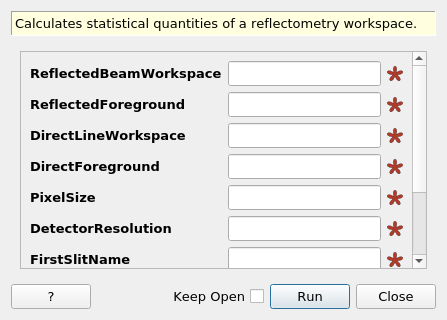\(\renewcommand\AA{\unicode{x212B}}\)
ReflectometryBeamStatistics v1¶

ReflectometryBeamStatistics dialog.¶
Summary¶
Calculates statistical quantities of a reflectometry workspace.
See Also¶
Properties¶
Name |
Direction |
Type |
Default |
Description |
|---|---|---|---|---|
ReflectedBeamWorkspace |
InOut |
Mandatory |
A reflected beam workspace. |
|
ReflectedForeground |
Input |
int list |
Mandatory |
A list of three workspace indices [start, beam centre, end] defining the reflected foreground. |
DirectLineWorkspace |
InOut |
Mandatory |
A direct beam workspace. |
|
DirectForeground |
Input |
int list |
Mandatory |
A list of three workspace indices [start, beam centre, end] defining the direct foreground. |
PixelSize |
Input |
number |
Mandatory |
Detector pixel size, in meters. |
DetectorResolution |
Input |
number |
Mandatory |
Detector pixel resolution, in meters. |
FirstSlitName |
Input |
string |
Mandatory |
Name of the first slit component. |
FirstSlitSizeSampleLog |
Input |
string |
Mandatory |
The sample log entry for the first slit opening. |
SecondSlitName |
Input |
string |
Mandatory |
Name of the second slit component. |
SecondSlitSizeSampleLog |
Input |
string |
Mandatory |
The sample log entry for the second slit opening. |
Description¶
This algorithm computes quantities needed by ReflectometryMomentumTransfer and ReflectometrySumInQ, and adds the results to the sample logs of ReflectedBeamWorkspace. The following sample logs get added:
beam_stats.beam_rms_variation\(=2 \sqrt{2 \ln 2} s \sqrt{\sigma}\), where \(s\) is PixelSize and \(\sigma\) is the variance of the intensity (integrated over all wavelengths) distribution of the detectors in the foreground region.
beam_stats.bent_sample1 if the sample can be regarded as non-flat and the beam is collimated, 0 in the case of divergent beam.
bean_stats.first_slit_angular_spread\(=0.68 x_{slit1} / d_{slits}\), where \(x_{slit1}\) is the size of the first slit and \(d_{slits}\) is the distance between the first and second slit.
beam_stats.incident_angular_spread\(=0.68 \sqrt{x_{slit1}^2 + x_{slit2}^2} / d_{slits}\), where \(x_{slit1}\) is the size of the first and \(x_{slit2}\) the size of the second slit while \(d_{slits}\) is the distance between the slits.
beam_stats.sample_wavinessThe heuristically calculated root mean squared sample waviness.
beam_stats.second_slit_angular_spread\(=0.68 x_{slit2} / (d_{slit2} + l_2)\), where \(x_{slit2}\) is the size of the second slit, \(d_{slit2}\) is the second slit-to-sample distance and \(l_2\) is the sample-to-reflected foreground centre distance.
Additionally, beam_stats.beam_rms_variation is cached to the sample logs of DirectLineWorkspace removing the need to recalculate the quantity every time the same direct beam passed to this algorithm.
Usage¶
Example - ReflectometryBeamStatistics
dir = Load('ILL/D17/317369.nxs')
ref = Load('ILL/D17/317370.nxs')
ReflectometryBeamStatistics(
ReflectedBeamWorkspace=ref,
ReflectedForeground=[199, 202, 205],
DirectLineWorkspace=dir,
DirectForeground=[200, 202, 205],
PixelSize=0.001195,
DetectorResolution=0.00022,
FirstSlitName='slit2',
FirstSlitSizeSampleLog='VirtualSlitAxis.s2w_actual_width',
SecondSlitName='slit3',
SecondSlitSizeSampleLog='VirtualSlitAxis.s3w_actual_width')
run = ref.run()
bent = run.getProperty('beam_stats.bent_sample').value
print('Bent sample? {}'.format('yes' if bent == 1 else 'no'))
rms = run.getProperty('beam_stats.beam_rms_variation').value
print('Beam RMS variation: {:.3}'.format(rms))
run = dir.run()
rms = run.getProperty('beam_stats.beam_rms_variation').value
print('RMS variation cached in dir: {:.3}'.format(rms))
Output:
Bent sample? no
Beam RMS variation: 0.00236
RMS variation cached in dir: 0.00208
Categories: AlgorithmIndex | ILL\Reflectometry | Reflectometry
Source¶
C++ header: ReflectometryBeamStatistics.h
C++ source: ReflectometryBeamStatistics.cpp
